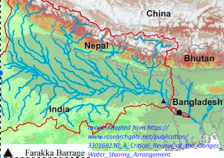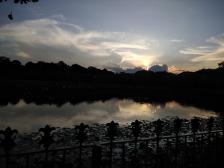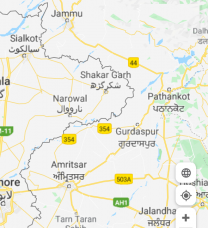
When our member Ms Sukla Gupta moved to Farakka with her husband, she found herself building a school. She invested it with love and compassion to raise a fine crop of graduating adults
The sleepy town of ...
When our member Ms Sukla Gupta moved to Farakka with her husband, she found herself building a school. She invested it with love and compassion to raise a fine crop of graduating adults
The sleepy town of Farakka suddenly came alive when, in the early sixties, it became the site for a barrage. There was an influx of migrant labour and suppliers of all kinds. Ms Gupta’s husband had moved to Farakka as a contractor for the barrage. The administration must have realized that the place needed a school for the children of those who were arriving in various capacities around the massive construction.
Ms Gupta along with few others applied for the position of teachers and got selected after the interview. But where was the school building? Where were the students? The government woke up to its task and constructed a building, where the school was started on March 5, 1964. Some 60 children, local and others of the barrage employees’ joined. The number increased as the school became a second home for the students, given the unique love and care of their teachers.
For Ms Gupta, it was time to shower on her students the same compassion and attention that she had received from her teachers at Shantiniketan. Children were to be nurtured and never punished and school took to the Shantiniketan path of learning. There was a period of great stress in the seventies and the children needed special nurturing.
Many of them are well settled in life today. By the time she retired the school was flourishing with 2,200 students.
Her point? Treating minor and major issues of the young generation with love and care is the best way to address them. If only the present generation started thinking this way!
Want to share your experience? Please mail your story to writetous@supportelders.com with your name

Around 1958, the city of Calcutta got the Dhakuria Lakes. This was a man-made water body, spread over 73 acres, beautifully dressed up with trees, plants and shrubs, giving the growing city a vast blue expanse. It was this idyll that ...
Around 1958, the city of Calcutta got the Dhakuria Lakes. This was a man-made water body, spread over 73 acres, beautifully dressed up with trees, plants and shrubs, giving the growing city a vast blue expanse. It was this idyll that our Member Mr A. Rakhshit remembers, not more than a five-minute walk from his ancestral home at Mudiali. He would undertake this walk with his father every morning, return home, have a bath, after a mustard oil massage that was routine for children then, before going off to school.
The lake was resplendent in its natural attire, unfettered by concrete boundaries, the surrounding parks rich with biodiversity. Trees apart, there were innumerable migratory birds and even little-known local birds that made for a birdwatcher’s delight. The quaint benches were inviting for adda enthusiasts and in the winter months the child would happily blow puffs of "cloud smoke".
The park was always open and couples spent hours doing what they do best. No one disturbed them because that was not considered “dignified” by the self-respecting. When it rained, the boys added to their merriment by jumping into the lake, beyond permitted hours for swimming. This was followed by a customary cuppa from the roadside stall that still sells tea. Only, today, the seller is the son of the original owner.
There was also the very pucca Calcutta Rowing Club that was reserved for the British and no Indian dared cross over the bamboo fencing. All that the boys did was to get a whiff of the food being cooked in the club when they walked by.
Even today Mr Rakhshit makes nostalgic visits to the park to recapture his childhood and meet his friends. Sadly, the childhood idyll is gone, the lake has lost its pristine charm but the attraction of old friends is hard to resist.
Want to share your experience? Please mail your story to writetous@supportelders.com with your name

Life in the barracks can be fearful, especially when in the border areas, under constant threat of fusillade from enemy aircraft. Our member, Group Captain D. De, posted as ground engineer with the Indian Air Force during the 1971 Indo-Pak ...
Life in the barracks can be fearful, especially when in the border areas, under constant threat of fusillade from enemy aircraft. Our member, Group Captain D. De, posted as ground engineer with the Indian Air Force during the 1971 Indo-Pak war, recounts some spine-chilling moments though nothing he said was quite as entertaining than the story of his little daughter treating the dropping bombs as fireworks.
Barely 40 kms from the Indo-Pak border, at Pathankot, is one of India’s most strategically located airbases. When the country is at war, it becomes especially critical for launching attacks. It was for our member, Group Captain De, posted as ground engineer with the Indian Air Force, during the 1971 war, to ensure that every fighter plane took off and landed safely. They were often engaged in deep raids into Pakistan territory and withstood retaliatory attacks during the wars of 1965 and 1971.
Group Captain De, an excellent raconteur, produced a spine-chilling account of his time there, the excitement of the trenches under regular bombardment post sundown writ large on his face even when recounting the tale several years later. On ideal days, the Indian Air Force could pre-empt such attacks, taking off early and positioning aircraft at a level higher than the Pakistan fighter jets. Sometimes, enemy planes entered by stealth and then the trench became the only option for officers, jawans and families.
The bombing over – there was minimal loss of lives during Group Captain De’s tenure – the hunt for unexploded bombs in the surrounding agricultural fields would commence. There was never an easy day. Pakistan had no fixed time for its raids. So, to the trenches it was, post sundown. Everything was pitch dark to avoid detection but the most important thing was building secure trenches.
It was for Group Captain De to successfully address the challenge of digging a 30ft by 15ft trench, about 8ft deep, in a record eight hours and covering it with dry leaves and plants for an effective camouflage. Only the aerials stayed outside the cover to catch signals of enemy aircraft and enable the launching of many a successful counter attack.
If this was not excitement enough, the Group Captain’s one-year old daughter chose to make matters interesting. This was before officers’ families were shifted to the safety of their hometowns. The Pakistan jets were showering bombs but, because of friction with airwaves, they started descending like firecrackers that are commonplace in India. There was the little Miss De clapping and shouting “Shadi hya”, welcoming the bombs as is they were bringing in a baraat.
It was left to a child to show the Pakistan Air Force its place!
Want to share your experience? Please mail your story to writetous@supportelders.com with your name

Our member Ms. Binapani Chatterjee travelled extensively with her mother, sister and few other close relatives to different parts of the world. Her sister studied in Germany, she is well aware of the beautiful places of Europe. She suggested ...
Our member Ms. Binapani Chatterjee travelled extensively with her mother, sister and few other close relatives to different parts of the world. Her sister studied in Germany, she is well aware of the beautiful places of Europe. She suggested to visit Rijeka (pronounced as Riyaka) at Croatia. An inlet of the Adriatic Sea, a low-key destination, less popular with Indian tourists. This only akes it surreal.
It was middle of 2019 Ms. Chatterjee visited Rijeka, the Western Croatian city, by road. Rijeka, major port and industrial, commercial, and cultural centre of western Croatia, is located on the Kvarner (a gulf of the Adriatic Sea) and is the country’s major port. Rijeka carriesthe symbol of water in its name. It literally means River in Croatian language. “Driving by thehighway from Zagreb, we first climbed high mountains of Julian Alps. Then we took a sharpdescent to the plains of Adriatic Sea. Rijeka emerges between the hills where Rjecina river flowsinto the Adriatic Sea. We have heard about this beautiful European seaside and Rijeka was truly stunning.” They stayed in the 11 th floor of a 12 storied hotel where they got the best view of the city and the Adriatic Sea. A walk on Korzo, that runs parallel to the waterfront and gives the opportunity to view the Adriatic Sea, is one of the best things to do in Rijeka. One can soak up Croatian daily life and feel the rhythm and spirit of the city, that will make you love it.
The city's economy largely depends on shipbuilding and maritime transport. They travelled around the city to get the feel of their culture and tradition and more so, it’s scenic beauty.To appreciate Trsat Castle, a thirteenth century Roman Fortress, one of the worth visiting place in Rijeka. One must stand at the crest of the steep hill next to the Rjecina Gorge and have a look in the ancient time architecture. The turquoise blue sky and the spectacular view of Adriatic Sea made it a unforgettable for them. “We felt really blessed that we took a pause to discover the charm of this bustling seaside of Croatia.”
Want to share your experience? Please mail your story to writetous@supportelders.com with your name

Our member Mr. Ravinder Kumar Puri was associated with the much-known Union Carbide India Limited and he travelled through out the country for his posting. He shared some of his beautiful memories of Bhopal prior ...
Our member Mr. Ravinder Kumar Puri was associated with the much-known Union Carbide India Limited and he travelled through out the country for his posting. He shared some of his beautiful memories of Bhopal prior to the tragedy.
Mr. Puri was posted in Bhopal for 3/4 years during late 70s. The quite sleepy town with people of laid-back attitude, scattered hillocks, river Betwa, two skyline silver coloured lakes everything came alive in his mind while describing. Once a princely state and suzerainty of the Nizam of Hyderabad, people had their inborn “princely” attitude! “We spend a wonderful time there with a stunning garden full of roses, a big bunglow and some beautiful people.” The Union Carbide plant the 2nd in the world after the US plant, completed in front of his eyes. Mr. Puri’s job was to depute people for the factory. “We had to constantly tell and remind staff there that a small amount of the chemical can destroy Bhopal and if the whole chamber burst it can destroy the whole of Madhya Pradesh, so you have to work really cautiously.” But that will turn into reality, he might have never dreamt of. He used to visit the plant every now and then even after he was transferred to Mumbai and eventually to Kolkata and the tragedy happened in 1983. “The devastation is known to all, but we were deeply disturbed because many of our friends and colleagues got affected due to the tragedy.” The highly toxic substance made its way slowly with air around the small towns located near the plant. Though the cause of the disaster remains under debate, but finally it is a single drop of water that entered the gas chamber which caused the devastation.
“We have never been to Bhopal after the tragedy”- may be because of the fear that the air is still intoxicated or maybe they don’t want to see their loving workplace transformed into an abandoned place with a deserted look.
Want to share your experience? Please mail your story to writetous@supportelders.com with your name

